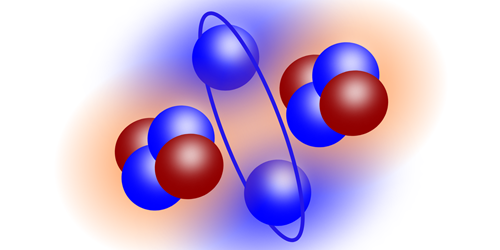Home / News / Highlights
24 11, 2023
Physicists Discover Molecule-like Structure of Nuclear Ground State
Scientists from the Institute of Modern Physics (IMP), Chinese Academy of Sciences (CAS), along with their collaborators, have recently discovered a molecular-type structure in the ground state of atomic nuclei. 

This research was published in Physical Review Letters on November 21 and highlighted as "Featured in Physics".
The atomic nucleus, a quantum many-body system composed of protons and neutrons, is incredibly small (only about one-ten-thousandth the size of an atom), but it houses over 99.9% of an atom's total mass. Interactions between nucleons create various intriguing nuclear structures, ranging from spherical to deformed nuclei, and even neutron halos with sparse surface density. The emergence of cluster structures within these formations is a captivating phenomenon.
Cluster structures are rarely seen in the ground state of atomic nuclei. Discussions on ground-state cluster structures can be traced back to 1938 when theoretical physicists, through the analysis of binding energies in α-conjugate nuclei, suggested the possible existence of α-molecule-like cluster structures in the ground states of nuclei such as beryllium-8, carbon-12, and oxygen-16. However, due to the popularity of the classical shell model's single-particle description, this theoretical hypothesis has remained unverified.
Using a novel experimental method of the inverse kinematics knockout reaction, the researchers from IMP and their collaborators have validated the presence of a molecular-type structure in the ground state of beryllium-10, a neutron-rich nucleus.
This experiment was conducted at the Radioactive Isotope Beam Factory (RIBF) at the RIKEN Nishina Center in Japan. In the experiment, a secondary beam of beryllium-10, traveling at half the speed of light, bombarded a 2-millimeter-thick solid hydrogen target. The α-clusters bound within beryllium-10 nuclei were knocked out by protons, transferring almost no momentum to the residual nucleus, thus preserving information about the cluster structure in the ground state of beryllium-10.
The experimental results demonstrated a remarkable agreement between the experimental cross-sections of knockout reactions and theoretical predictions under microscopic models. This verification supports the long-standing hypothesis regarding the molecular-state structure of beryllium-10's ground state, suggesting the formation of an α-α dumbbell-shaped core with two valence neutrons rotating perpendicular to the core axis.
“Similar structures can be found on the atomic scale, but they are exceptionally rare in the ground state of atomic nuclei,” said Dr. LI Pengjie from IMP, the first author of this paper.
This study provides the first experimental evidence for the theoretical description of molecular-state structures in the ground state of atomic nuclei and paves the way for further exploration of the evolution of α-cluster structures in neutron-rich nuclear ground states.
This research was conducted in collaboration with researchers from the University of Hong Kong, Paris-Saclay University in France, RIKEN and Osaka University in Japan, Nanjing University of Aeronautics and Astronautics, and 22 other research institutions worldwide.

Fig. 1 Schematic view of the cluster knockout reaction in inverse kinematics. (Image by LI Pengjie)

Fig. 2 Molecular-like structure of the beryllium-10 nucleus. (Image by LI Pengjie)
Appendix(s):
Contact Information
Institute of Modern Physics
Email: fangliu@impcas.ac.cn



 甘公网安备 62010202000713号
甘公网安备 62010202000713号


